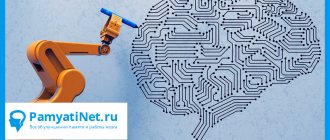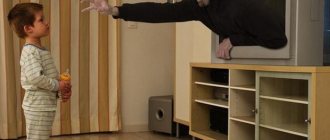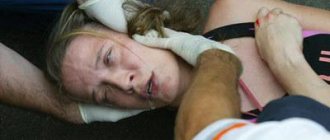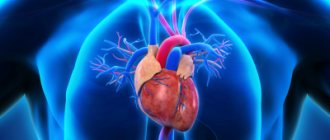VIEW OTHER SMP
Epilepsy is a chronic brain disease.
An epileptic (convulsive) seizure is a nonspecific reaction of the central nervous system in the form of partial or generalized convulsive attacks. Partial (focal, local) seizures - contraction of individual muscle groups while maintaining consciousness. Generalized seizures are convulsions of the whole body with impaired consciousness.
Status epilepticus is a convulsive seizure lasting more than half an hour or repeated seizures without full recovery of consciousness between them.
Epileptic syndrome is the body's reaction to an influence or pathological condition, including epilepsy, epileptic seizures and status epilepticus.
Symptoms of status epilepticus
Symptoms of epistatus are expressed in circulatory disorders, disturbances of consciousness (the person “switches off”), and disruption of the respiratory system. Symptoms of status epilepticus are a consequence of previous seizures from which the patient does not recover.
Epistatus can be characterized by a frequency of attacks up to 20 per hour. The patient does not regain consciousness at the onset of the subsequent seizure; his condition can be described as numbness bordering on coma.
The comatose state worsens in direct proportion to the duration. Tonic spasms affect the muscles of the back, arms and legs. High blood pressure suddenly drops. Increased reflexivity is also unexpectedly replaced by a complete lack of reaction.
Respiratory and circulatory disorders become obvious. When the seizures disappear, epileptic prostration occurs.
The duration of the epistatus is at least 30 minutes. Usually, as expected, we draw a line between this condition and episodic seizures with partial restoration of physiology and consciousness (full or partial).
There are two phases that characterize epileptic convulsive status with the following features:
- Compensatory changes in the circulatory and metabolic system, expressed in high blood pressure, vomiting and nausea, uncontrolled urination and defecation.
- Coming in about half an hour/hour, it is a maladaptation of compensatory changes, which is expressed in acute renal failure (and liver failure), a sharp decrease in pressure, disruption of the respiratory system, and arrhythmia.
Epistatus, the course of which is not accompanied by convulsions, is characterized by complete immobility of the patient and a feeling of detachment. Usually the patient lies with his mouth open, his blank gaze does not express anything.
CLINIC
Partial seizures
— Consciousness is preserved in most cases
— Loss of contact with others for 1-2 minutes
— Possible gradual involvement of new muscle groups in seizures (Jacksonian epilepsy)
— After a seizure, confusion for 1-2 minutes
- When consciousness changes, he forgets about the seizure
— Automatisms
— Impaired sensitivity
- Sometimes they develop before generalized seizures (Kozhevnikov epilepsy).
Generalized seizures
- Possible aura
- Screaming before a seizure
— Loss of consciousness with dilated pupils without reaction to light
- A fall
- Tongue biting
— Short-term tonic convulsions with cessation of breathing turn into 1-5 minute clonic convulsions with rhythmic twitching of the limbs
- Possible involuntary urination
Status epilepticus
— Seizures follow each other, consciousness is not fully restored.
Differential diagnosis of generalized seizures
| Criteria | Epileptic seizure | Psychogenic seizure | Fainting | Cardiogenic syncope (Morgagni-Adams-Stokes) |
| Development of lying and sitting | Yes | Maybe | Rarely | Maybe |
| Development in a dream | Yes | No | No | Maybe |
| Aura | Yes | Variable | Dizziness, darkening of the eyes, sweating, drooling, tinnitus, yawning. | Rarely |
| Focal symptoms | Possible | No | No | No |
| Tonic-clonic seizures | Earlier than 30 seconds from the onset of the attack | Diverse picture | 30 seconds after fainting | 30 seconds after fainting |
| Change in complexion | Initially hyperemia or cyanosis | No change or redness | Pallor | First pallor, then hyperemia |
| Tongue biting | Yes and on the sides | No or in the middle | Rarely | Rarely |
| Involuntary urination | Yes | No | No | Maybe |
| Damage from falling | Often | No | No | Possible |
| Confusion after | Yes | No | No | No |
| Pain in the limbs | Yes | No | No | No |
| Amnesia | Yes | No | Partial | Partial |
Causes of pathology
Status epilepticus manifests itself as a complication of epilepsy, but can also be its manifestation. The attacks last more than 30 minutes and pose a direct threat to human life.
Epistatus most often develops in the symptomatic form of epilepsy; it can also occur in idiopathic form.
It is necessary to differentiate status epilepticus from serial epileptic seizures, between which the patient’s consciousness is restored and there is no disruption of the functioning of organs and systems. However, serial seizures can lead to epistatus.
The disease occurs due to continuous electrical activity of brain neurons. Pathological excitation spreads through the neural circuits that support this activity.
It turns out to be a vicious circle that is not easy to break. The difference between epistatus and a generalized attack is that the latter has clearly defined phases: tonic and clonic.
In status epilepticus, these phases cannot be distinguished. The patient is unconscious and has complete areflexia.
The causes of the disease may be:
- abrupt cessation of taking antiepileptic drugs;
- simultaneous use of anticonvulsants and sedatives or hypnotics;
- drinking alcohol;
- neoplasms in the brain;
- strokes;
- head injuries;
- infections (encephalitis, meningitis, polio, influenza);
- hypoglycemia;
- intoxication due to exposure to harmful chemicals;
- dysmetabolic disorders (uremia, hyponatremia);
- acute renal and adrenal failure.
Thus, the occurrence of pathology is not always associated with epilepsy. Children are more susceptible to the disease.
Sometimes such attacks in children are a consequence of severe influenza, when the temperature rises to critical levels.
Often in children, epistatus indicates congenital pathologies of brain development.
PREHOSPITAL TREATMENT
General activities:
- — If breathing and/or circulation stops, perform cardiopulmonary resuscitation.
- - Lay the patient down, turn his head to the side, unfasten the collar and belt of the trousers.
- - Hold and protect from self-injury, if possible, place your head on something soft.
- — Restore airway patency: press on the chin with the palm of your right hand, pull back the lower jaw, reach for the tongue, (remove dentures), clear the mouth of mucus and blood.
- — Between paroxysms, to prevent tongue retraction and maintain airway patency, insert an airway, a nasogastric tube and an intravenous catheter
Treatment of status epilepticus:
Stopping seizures
- 2–4 ml of diazepam (Seduxen, Relanium, Sibazon) per 10 ml of NaCl IV slowly or 0.5-1.0 mg/kg Convulex IV slowly
- If convulsions persist after 10 minutes, repeat administration of benzodiazepines
- Prevention of rhythm disturbances in the elderly 10 ml of panangin per 10 ml of NaCl intravenously or 10 ml of 10% KCl
- If convulsions persist after 15 minutes, inhalation administration of oxygen and sodium thiopental
Relief of pathological conditions
Hypoglycemia (glucose less than 5 mmol/l)
- 2 ml 5% thiamine IV (prevention of acute Gaiet-Wernicke encephalopathy)
- 50 ml 40% glucose IV
Arterial hypertension:
- with tachycardia, 10–30 mg of anaprilin (obzidan), crushed and administered through a probe with a small amount of water
- , crush 20–40 mg of corinfarum atropine intramuscularly
Hyperthermia:
- 2–4 ml of 50% analgin intramuscularly
Severe headache after an attack:
- optimally - tramadol (Tramal), but other drugs are also possible
Emergency care for status epilepticus
First aid for status epilepticus, before the arrival of doctors, is the need to protect the patient from receiving mechanical injuries. There is no need to crowd around the patient, blocking free access to clean air.
Our recommendations:
- Place the patient on a non-traumatic surface with something soft (jacket, sweater) under his head;
- To avoid choking on saliva, carefully turn your head to the side;
- Remove the tie, belt, unbutton the collar so that nothing interferes with the patient’s ability to breathe freely;
- Remove all sharp and traumatic objects located nearby;
- If your teeth are clenched, there is no need to unclench them;
- If your mouth is open, place any soft cloth between your teeth.
You should not place sharp, metal or other objects between your teeth that could cause injury to an unconscious person.
Emergency care for status epilepticus should be provided very carefully. You should not hold the patient too tightly so as not to damage his bones (in this condition the likelihood of fractures is very high).
Algorithm for providing assistance
The principle of action for providing assistance to a patient with epilepsy should be as follows:
- There is no need to panic - such an attack will not pose a threat to the patient if he is given proper assistance.
- Look around to see if there are any objects that could injure a person. If there are any, move them to the side.
- It is also necessary to note the time of the onset of the attack to assess its duration.
- Free the patient from restrictive items of clothing - tie, belt, etc.
- The victim should place something soft under his head to protect him from hitting the floor or asphalt.
- Turn the victim onto his or her side to prevent vomit or foam from entering the respiratory tract.
- In cases where a person has bitten his tongue, his lower jaw should be pulled back with a scarf or a piece of dense fabric.
- During an attack, in some cases the patient experiences a short-term cessation of breathing. Therefore, it is necessary to monitor his pulse.
What types of seizures do people experience most often?
- obvious, recognizable (tonic-clonic seizure, complex focal disorders);
- less noticeable (aura, absence seizures...).
Less obvious seizures may not cause a reaction from others, because they can be confused with the characteristics of a person’s behavior (looking at one point, does not answer the question - lost in thought, a sudden change in mood is also possible).
Symptoms that are not so dangerous in appearance can be a sign of an approaching serious attack (as an aura). Or they can occur on their own without causing complications.
In any case, if a mild form of epilepsy occurs (or is suspected), the person should be protected from all negative external factors (noise, cold, heat), not try to restrain him in his actions, and help him become as comfortable as possible.
Whatever the causes of an epileptic attack, first aid should be provided quickly and correctly.
Characteristic
The prevalence of the pathology is about 10 cases per 1 thousand population. In total, there are about 50 million patients in the world. Most of them are children and teenagers. Patients who have epilepsy are 3 times more likely to die prematurely. Adequate medical care for epilepsy is an effective measure to prevent seizures. Studies show that in 70% of patients, the development of attacks can be prevented if the disease is treated correctly.
During an epileptic seizure, it is important to help the patient in order to avoid complications, such as with convulsive status - pulmonary edema, impaired respiratory and cardiac activity. The diagnosis is made if there is a history of more than 2 attacks. In pediatric practice, to make a diagnosis, 1 attack in history is sufficient against the background of a high probability of its recurrence (according to the results of electroencephalography).
Drugs for treatment and relief agents
Pathology therapy is selected depending on the cause. If the cause lies in a brain tumor, then the issue of surgical removal of the formation is resolved.
In other cases, the following drugs are administered to the patient:
- Anticonvulsants: Diazepam is a tranquilizer with anticonvulsant and anti-edematous effects. Muscle relaxant. Sibazon is a muscle relaxant with a sedative effect.
- Diuretics (to prevent brain swelling). Mannitol. Acetazolamide.
- Barbiturates. Phenobarbital is an anticonvulsant sedative drug. Suppresses the sensory area of the cerebral cortex.
Along with anticonvulsants, the patient is administered drugs that support vital functions:
- Corticosteroids (Prednisolone). Indicated for diabetes, poisoning, infections.
- Blood pressure lowering agents (Clonidine).
- Cardiovascular drugs (Eufillin).
- Stimulating respiratory function (Cordiamine).
- Preventing blood clotting (Curantil, Heparin).
- Vitamins (B6).
If the attack cannot be stopped within an hour, then the patient is given general anesthesia with Thiopental or Propofol. Anesthesia is continued for 24 hours after the last attack.
When ES is stopped, the patient is prescribed therapy according to the severity of the complications. If the status is caused by epilepsy, then the patient requires lifelong use of antiepileptic drugs.
Thus, ES therapy is carried out in several stages:
- Stopping an attack.
- Determining the cause of the pathology.
- Administration of anticonvulsants.
- Symptomatic help.
- Detection and treatment of complications.
- Prescription of long-term treatment.
About the treatment of epistatus in this video:
Epileptic seizure with psychomotor manifestations
This type of epilepsy attack is characterized by very multifaceted and varied symptoms.
It is often preceded by an aura in the form of a dream-like state. Darkness or loss of consciousness lasting about 2 minutes is observed. Oral automatism in the form of licking, swallowing, chewing and smacking movements, as well as bouts of coughing and snoring, are very often observed. Often patients make stereotypical, repetitive movements of the upper and lower extremities.
There are tugging, scraping and scratching movements. Complex automatism in movements is observed: pulling and straightening of limbs, “running in bed”, etc.
The patient retains amnesia about the essence and manifestations of these seizures. Very rarely in such patients one can observe a psychomotor status, which manifests itself in the form of a constant aura or a twilight state of consciousness. This status is often accompanied by automaticity in movements and lasts from several hours to several days.
Preparing for an attack
An epileptic seizure can occur completely suddenly, or can be provoked by certain external factors (for example, flickering light, photo flash, sharp sounds, stressful situations, lack of sleep, alcohol abuse and other strong irritants) or occur in a person only in certain conditions (for example, during menstruation or only during sleep).
Knowing the relationship between seizures and such factors, you can significantly reduce their risk of occurrence.
Also, the occurrence of an epileptic attack may be preceded by an aura - a kind of harbinger of an approaching seizure.
It could be:
- the occurrence of causeless anxiety or fear;
- sudden mood swings;
- unreasonable excessive irritability, fatigue, drowsiness, etc.
The aura appears before an attack 1-2 days or several hours before
.
During the aura period, a person can have time to protect himself: inform others or ensure his safety by removing traumatic objects.
An epileptic driver hid his diagnosis when obtaining a license.
In the Central District Court of Novokuznetsk, hearings began in the case of a high-profile accident on Kurako Avenue. In July 2016, the owner of a foreign car lost consciousness and drove into a crowd of people at a busy crossing, injuring five pedestrians. It turned out that during the medical examination, Maxim Ilyin, born in 1988, hid from specialists that he had a disability.
A road accident near the station square of Novokuznetsk occurred at eleven o'clock in the morning. The driver of a Nissan March suddenly started driving at a prohibitory traffic light. At a pedestrian crossing, an out-of-control car hit people, and then, hitting a curb,
drove into oncoming traffic and stopped, colliding with another car. Three women injured in the accident were hospitalized in medical institutions with bruises, fractures and head injuries. Two more city residents were assisted by specialists from the trauma center. Before the ambulance arrived, eyewitnesses to the accident tried to help the driver of the foreign car, who lost consciousness. He almost did not react to what was happening and did not understand that he had hit people. The man who had a seizure was taken to the intensive care unit of the 29th city hospital. Residents of Novokuznetsk, who learned about the accident from the media and watched the recording of the moment of the collision on social networks, wondered: how was a person with epilepsy given permission to drive a vehicle? What responsibility will a driver bear if he injures pedestrians? The police officers investigating the traffic accident also had to answer these questions.
During the investigation, it became clear under what circumstances a resident of Novokuznetsk received a driver’s license
and what disease he suffers from. Several years ago, Maxim Ilyin had a seizure at his workplace. Doctors from the neurosurgical department of Hospital No. 29 provided assistance to the patient and diagnosed him with “symptomatic epilepsy.” To eliminate the causes of the disease causing seizures, the Novokuznetsk resident underwent surgery at the Kemerovo Regional Hospital. After discharge, Maxim Ilyin, who received disability group 2, was under the supervision of a neurologist and took medications for headaches. After completing the course of treatment, doctors strongly recommended that the patient avoid any work related to driving vehicles. It must be said that in the presence of nervous diseases, such as epilepsy, the patient should not drive at all. Epilepsy is a medical contraindication to driving, as the patient is potentially dangerous on the road. It is impossible to predict at what moment an attack will occur. But, apparently, the 28-year-old resident of Novokuznetsk decided that he was completely cured and there were no contraindications for driving a personal car. In May 2020, Ilyin passed a medical examination to replace his driver’s license. He provided information from a psychiatric hospital and a drug treatment clinic, where he was not registered. However, the motorist did not show the outpatient card to the doctors at the clinic. When asked whether there were any health complaints or whether he had undergone complex operations, the patient answered negatively. Maxim Ilyin also “forgot to say” that he has a disability group and previously had seizures. Taking the patient’s word for it, the doctor issued a certificate that did not interfere with obtaining a license. Law enforcement officials also learned that literally the day before the accident, an ambulance team took Maxim Ilyin to the hospital, where he received the necessary assistance. Believing in his own strength and neglecting safety rules, the disabled person got behind the wheel of a foreign car that same day and hit pedestrians after a sudden seizure.
The culprit of the accident, against whom a criminal case was initiated, underwent a forensic psychiatric examination. Based on its results, a commission of specialists came to the conclusion that due to his illness, Maxim Ilyin cannot take part in investigative actions and trial proceedings. According to experts, the man is “socially dangerous to himself and others” because he has a “serial and status course of epilepsy” and there is a high probability of recurrence of epileptic seizures with a disorder of consciousness. The experts considered it necessary to subject him to compulsory treatment in a medical organization providing psychiatric care in a general inpatient setting. Maxim Ilyin’s legal representative was his mother.
Despite the recommendations of doctors, the culprit of the accident himself appeared at the court hearing. At the first meeting, a representative of the Novokuznetsk prosecutor's office announced the indictment. After this procedure, the court moved on to interrogating elderly women who were seriously injured in an accident on Kurako Avenue. The affected pensioners said they doubted the objectivity of the examination. Before the accident, the culprit of the road accident worked as a technician at one of the enterprises, drove a car and led a full-fledged lifestyle. According to the victims, the defendant is sane and adequate and should be punished for violating traffic rules. I also note that the court will consider the issue of depriving Maxim Ilyin of his driver’s license, which has currently been confiscated from him.
Aleksey Ivanov
Video: YouTube
NK-TV.COM
What not to do during an epileptic attack
During an epileptic attack, it is important not so much to do the right things as not to do the wrong ones:
- You should not try to open a person's teeth during a seizure. This can damage the enamel or mucous membrane of the oral cavity. This has no practical benefit: during the convulsive phase, all the muscles, including those responsible for the tongue, are tense, and it cannot recess. During the second phase, it is enough to turn your head to the side.
- You cannot hold a person by force during an attack. He does not feel pain and may accidentally injure muscles or ligaments. It is enough to hold your head or put something soft under it.
- Do not carry or move a person during a seizure. This may cause injury. The exception is when the place is a threat to life: the edge of a cliff, roadway, water.
- You should not try to give a person something to drink during an attack or give him any medications.
- You cannot hit him in the face, shout, or disturb him, trying to bring him to his senses.
- Do not perform artificial respiration or chest compressions.
These are the mistakes most often made by bystanders of epileptic seizures.
Jackson's focal epileptic seizure
It manifests itself in paroxysmal motor (clinical or myoclonic) convulsions and/or sensory disturbances in the form of parasthesias, crawling sensations, burning sensations, and pain while maintaining consciousness.
All this is felt in the peripheral parts of the limbs or on one half of the face with a tendency to spread to the corresponding half of the body. The duration of the attack is from 10-20 s to several minutes. It may transform into a classic generalized attack of convulsions with loss of consciousness.











